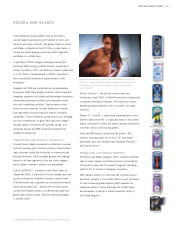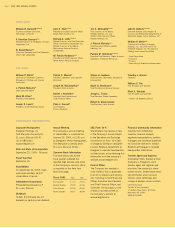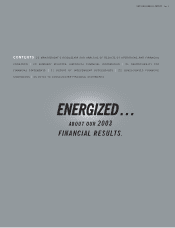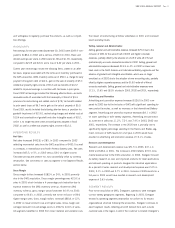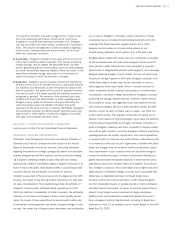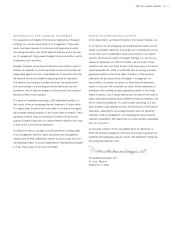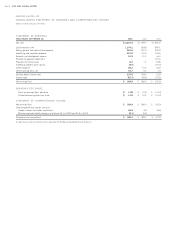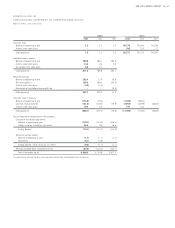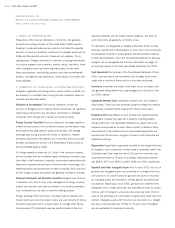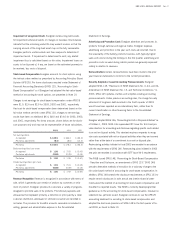Energizer 2003 Annual Report Download - page 19
Download and view the complete annual report
Please find page 19 of the 2003 Energizer annual report below. You can navigate through the pages in the report by either clicking on the pages listed below, or by using the keyword search tool below to find specific information within the annual report.ENR 2003 ANNUAL REPORT Page 17
al contributed to the site, the number of other PRPs and their financial
viability, and the remediation methods and technology to be used.
In addition, Energizer undertook certain programs to reduce or eliminate
the environmental contamination at the rechargeable battery facility
in Gainesville, Florida, which was divested in November 1999.
Responsibility for those programs was assumed by the buyer at the time
of the divestiture. In 2001, the buyer, as well as its operating subsidiary
which owns and operates the Gainesville facility, filed petitions in bank-
ruptcy. In the event that the buyer and its affiliates become unable to
continue the programs to reduce or eliminate contamination, Energizer
could be required to bear financial responsibility for such programs as
well as for other known and unknown environmental conditions at the
site. Under the terms of the Reorganization Agreement between Energizer
and Ralston Purina Company, however, which has been assumed by an
affiliate of The Nestle Corporation, Ralston’s successor, is obligated to
indemnify Energizer for 50% of any such liabilities in excess of $3.0.
Under the terms of the Stock and Asset Purchase Agreement between
Pfizer, Inc. and Energizer, relating to the acquisition of the SWS busi-
ness, environmental liabilities related to pre-closing operations of that
business, or associated with properties acquired, are generally retained
by Pfizer, subject to time limitations varying from two years to 10 years
following closing with respect to various classes or types of liabilities,
minimum thresholds for indemnification by Pfizer, and maximum limita-
tions on Pfizer’s liability, which thresholds and limitations also vary with
respect to various classes or types of liabilities.
Many European countries, as well as the European Union, have been
very active in adopting and enforcing environmental regulations. In
many developing countries in which Energizer operates, there has not
been significant governmental regulation relating to the environment,
occupational safety, employment practices or other business matters
routinely regulated in the United States. As such economies develop, it
is possible that new regulations may increase the risk and expense of
doing business in such countries.
Accruals for environmental remediation are recorded when it is probable
that a liability has been incurred and the amount of the liability can be
reasonably estimated, based on current law and existing technologies.
These accruals are adjusted periodically as assessments take place and
remediation efforts progress, or as additional technical or legal informa-
tion becomes available.
It is difficult to quantify with certainty the potential financial impact of
actions regarding expenditures for environmental matters, particularly
remediation, and future capital expenditures for environmental control
equipment. Nevertheless, based upon the information currently avail-
able, Energizer believes that its ultimate liability arising from such
environmental matters, taking into account established accruals of $9.7
for estimated liabilities at September 30, 2003, should not be material
to its financial position. Such liability could, however, be material to
results of operations or cash flows for a particular quarter or year.
MARKET RISK SENSITIVE INSTRUMENTS
AND POSITIONS
The market risk inherent in Energizer’s financial instruments and posi-
tions represents the potential loss arising from adverse changes in inter-
est rates, foreign currency exchange rates and stock price. The following
risk management discussion and the estimated amounts generated from
the sensitivity analyses are forward-looking statements of market risk
assuming certain adverse market conditions occur.
Interest Rates
At September 30, 2003 and 2002, the fair market value of Energizer’s
fixed rate debt is estimated at $336.9 and $200.0, respectively, using
yields obtained from independent pricing sources for similar types of
borrowing arrangements. The fair value of debt is lower than the carry-
ing value of Energizer’s debt at September 30, 2003 by $38.1, and the
fair value of debt exceeds the carrying value at September 30, 2002 by
$25.0. A 10% adverse change in interest rates on fixed-rate debt would
have increased the fair market value by $3.8 at September 30, 2003
and increased the fair value by $2.5 at September 30, 2002.
Energizer has interest rate risk with respect to interest expense on variable
rate debt. At September 30, 2003 and 2002, Energizer had $624.7 and
$94.6 variable rate debt outstanding, respectively. The book value of
Energizer’s variable rate debt approximates fair value. A hypothetical 10%
adverse change in all interest rates would have had an annual unfavorable
impact of $1.3 and $0.4 in 2003 and 2002, respectively, on Energizer’s
earnings before taxes and cash flows, based upon these year-end debt
levels. The primary interest rate exposures on variable rate debt are
short-term rates in the United States and certain Asian countries.
Foreign Currency Exchange Rates
Energizer employs a foreign currency hedging strategy which focuses on
mitigating potential losses in earnings or cash flows on foreign currency
transactions, which primarily consist of anticipated intercompany pur-
chase transactions and intercompany borrowings. External purchase
transactions and intercompany dividends and service fees with foreign
currency risk are also hedged from time to time. The primary currencies
to which Energizer’s foreign affiliates are exposed include the U.S.
dollar, the euro, the yen and the British pound.


